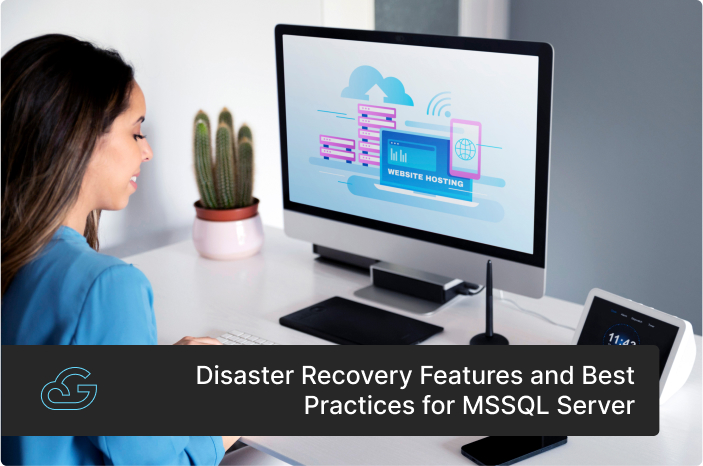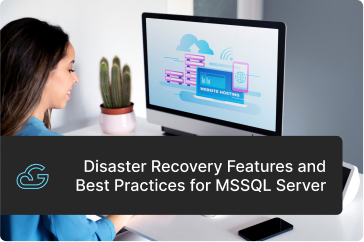Blogs / MS SQL Server
Disaster Recovery Features and Best Practices for MSSQL Server
By
Sibin Vincent
Posted: February 28, 2024
• 4 Minutes 10 Seconds
As businesses increasingly rely on Microsoft SQL Server to store and manage critical data, the risk of unexpected disruptions looms large. Any disruption to SQL Server operations can result in severe consequences, including financial losses, reputational damage, and regulatory non-compliance. Given these scenarios, disaster recovery planning is essential to ensure uninterrupted business operations, particularly in the face of unforeseen events like hardware failures, natural disasters, or cyber-attacks.
Factors Leading to Disasters in SQL Server
SQL Server faces numerous threats that can disrupt its stability and functionality. Let’s find out these factors.
- Hardware Failures: Malfunctions or breakdowns in server hardware components such as disk drives, memory modules, or CPUs can lead to system failures and data loss.
- Power Outages: Unexpected power outages or fluctuations can disrupt SQL Server operations. This disruption can result in data corruption or loss if transactions are not properly committed to disk.
- Software Bugs: Software bugs or glitches within SQL Server itself or related applications can cause unexpected behavior, system crashes, or data inconsistencies.
- Human Errors: Mistakes made by administrators or users, such as accidental data deletion, misconfiguration, or improper use of commands, can lead to data loss or corruption.
- Cyber Attacks: Malicious activities such as hacking, malware infections, ransomware attacks, or SQL injection attacks can compromise the security of SQL Server systems. These attacks can result in data breaches or system disruptions.
- Natural Disasters: Events like floods, earthquakes, fires, or severe weather conditions can damage physical infrastructure, including servers and data centers. This damage can lead to prolonged downtime and potential data loss.
To secure against such risks, comprehending the potential causes of disasters in SQL Server is vital. By understanding these factors, organizations can implement effective disaster recovery features to safeguard their data and maintain operational continuity.
Disaster Recovery Features of MSSQL
Microsoft provides a suite of built-in DR features within SQL Server to help you safeguard your data. These features encompass a range of functionalities designed to enhance data availability, minimize downtime, and facilitate rapid recovery in the face of unforeseen incidents. Let's explore the DR capabilities offered by Microsoft SQL Server.
-
Failover Clustering
-
Always On Availability Groups
-
Database Mirroring
-
Log Shipping
-
Active Geo-Replication
-
Auto-Failover Groups
This technology automatically switches operations to a secondary server if the primary server experiences hardware or software failures. Failover clustering, providing high availability, seamlessly transitions SQL Server instances from one node to another in case of disasters. This ensures minimal downtime and uninterrupted access to databases.
Always On Availability groups enable database mirroring and automatic failover between multiple replicas of a database. This feature creates highly available database solutions by enabling synchronous or asynchronous replication across multiple servers. It enhances data protection and availability, enabling organizations to offload read-only workloads and perform backups from secondary replicas.
Creating a real-time mirror copy of your database on a secondary server is the core of this technique. This allows for immediate failover in case of primary server issues. It provides automatic failover and synchronization between the principal and mirror databases, ensuring data availability and integrity.
Log shipping involves automatically backing up transaction logs from a primary database and restoring them to one or more secondary databases. It facilitates disaster recovery by maintaining warm standby databases for failover purposes. This enables point-in-time recovery to a specific point in time.
This advanced feature geographically replicates entire databases or specific data subsets across Azure regions with near real-time data synchronization. This facilitates disaster recovery across continents. It provides asynchronous replication and automatic failover for disaster recovery scenarios in the Azure SQL Database.
Auto-failover groups in Azure SQL Database enable automatic failover between primary and secondary databases in different regions. It ensures high availability and data redundancy for mission-critical applications and simplifies failover configuration and management for availability groups.
Best Practices for Implementing MSSQL Server Disaster Recovery Features
While SQL Server offers a comprehensive suite of built-in disaster recovery features, maximizing their effectiveness requires careful planning and implementation. Now let’s understand the best practices for leveraging MSSQL Server disaster recovery features effectively.
- Regularly test disaster recovery plans to ensure they work as expected in real-world scenarios. This helps to ensure the effectiveness and efficiency of your chosen recovery techniques.
- Conduct a thorough risk assessment to identify potential threats and prioritize DR strategies based on their likelihood and potential impact on your business.
- Automate critical disaster recovery processes like backups and failover procedures whenever possible to minimize manual intervention during a disaster.
- Consider leveraging cloud-based disaster recovery solutions for added scalability, flexibility, and cost-effectiveness.
- Seek expert guidance from experienced consulting professionals to design and implement a DR plan tailored to your specific needs and resources.
Why Disaster Recovery Strategies in SQL Server are Important
Imagine a scenario where an unexpected disaster throws your entire SQL Server operation into disarray. Critical data becomes inaccessible, applications halt, and your business faces negative consequences. This is precisely why implementing comprehensive disaster recovery (DR) strategies for your SQL Server environment becomes necessary. These strategies ensure that your SQL Server remains operational, even in the face of adversity. Let's find out how SQL Server DR strategies work for your businesses.
Mitigating Downtime
Downtime in SQL Server services will cause many problems. For instance, during downtime, employees may be unable to access important data and applications. This will lead to productivity losses and revenue impact. By implementing an efficient disaster recovery strategy, your organization can minimize downtime and ensure that SQL Server services remain accessible even in the event of disruptions.
Protecting Data Integrity
Data integrity is vital if your organization operating SQL Server databases. Any loss or corruption of data can have far-reaching consequences, impacting business operations and decision-making processes. A robust disaster recovery strategy protects data integrity by implementing regular backups and geographically dispersed database replication. Additionally, it ensures quick service restoration after failures through established failover mechanisms.
Meeting Compliance Requirements
Many industries are subject to regulatory requirements mandating the protection and retention of sensitive data. Failure to comply with these regulations can result in hefty fines, legal penalties, and damage to an organization's reputation. A well-defined disaster recovery strategy helps organizations meet compliance requirements by providing mechanisms for data backup, retention, and recovery, thereby mitigating the risk of non-compliance.
Safeguarding Business Continuity
Business continuity is essential for organizations to maintain operations, serve their customers effectively, and earn customer trust. An efficient disaster recovery strategy ensures uninterrupted service delivery by enabling organizations to quickly recover from disruptions and resume normal operations with minimal disruption. This includes implementing failover mechanisms, maintaining redundant systems, and regularly testing disaster recovery procedures to validate their effectiveness.
Gsoft Managed SQL Server Service for Efficient Disaster Recovery
Gsoft's Managed SQL Server service provides comprehensive support and expert guidance to help you implement and manage your DR strategy effectively. Our team of certified professionals can assist you with:
- Conducting a thorough assessment of your specific vulnerabilities and DR requirements.
- Designing and implementing a customized DR plan that aligns with your budget and infrastructure.
- Monitoring and managing your environment and proactively addressing potential issues.
- Ensuring a quick and efficient recovery process, minimizing downtime and data loss.
Ensure that unforeseen events do not disrupt your operations—invest in a comprehensive DR strategy to safeguard your business from potential disruptions. Contact Gsoft Cloud today to learn how our Managed SQL Server can help build an efficient strategy.


Get Know More About Our Services and Products
Reach to us if you have any queries on any of our products or Services.











